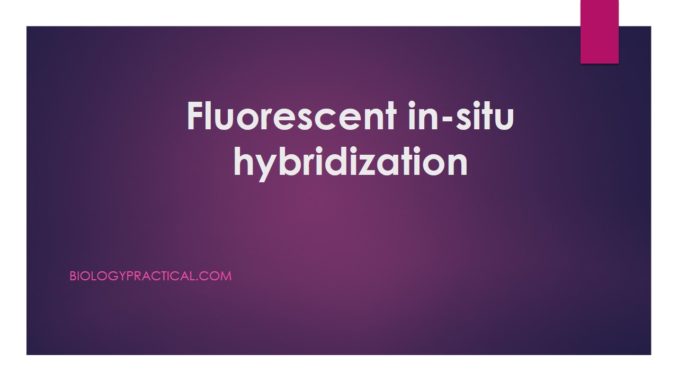
Modified in-situ hybridization
- The modification is seen in the detection system, which is based on a fluorescence signal instead of the coloured precipitate resulted by an enzymatic reaction.
- Advantages: Fluorescent system has two major advantages that make up for this relatively minor difficulty.
- The first advantage is a observable increase in sensitivity. It is possible to produce preparations in which the background fluorescence signal is virtually null under optimal hybridization conditions, thus achieving high signal-to-noise ratios.
- The combination of such high- quality preparations with any of the highly sophisticated fluorescence microscope systems, such as confocal microscopes or cool charge-coupled device (CCD)cameras, can detect accurately in comparison to enzymatic detection methods.
- The second advantage is the enhanced resolution. This is specially useful when more than one target sequence is being analysed at the same time.
- The fluorescent protocol can be employed for double or triple hybridization with multiple probes that can easily be detected using the appropriate non-overlapping fluorochromes.
- In such case, the location of the different target sequences can be determined without the constraints inherent to transmitted light microscopy.
- limitations:
- The main limitation of this protocol is the short-lived nature of the fluorescent signal.
- Unlike the products of enzymatic reactions, fluorescence vanishes away over time, and bleaches out rapidly when observed under the microscope.
- Therefore, fluorescence-based preparations are temporary.
Preparation of the Probe for In-situ Hybridization
- Mix up the reaction mixture containing:
- 5µl of 5 X oligo-labelling buffer minus dT (deoxy thymine)
- 1
µl of biotin-16-uridine triphosphate approximately 100 ng of DNA (boiled)
- 1 Klenow fragment of DNA polymerase (1 unit)
- Make up to a final volume of 25µl
with water.
- Leave it for about 2 hours at 37°C or overnight at room temperature for effficient labelling
- There is no need to remove unincorporated nucleotides because of the very high incorporation rates.
- Store this probe solution at -20°C for many months.
- Before hybridization, the probe should be diluted in 1 volume of water and 2 volumes of 2X hybridization buffer.
- Then it should be boiled for 3 minutes and quenched on ice before it is applied to the chromosomes.
